Illustrations from the 1930s Chinese magazine Modern Sketch![]() Modern Sketch issue #9
Chen Juanyin, “China’s Characters Who Count” (#1, Chiang Kai-shek...)
For the full background on this remarkable publication read John A Crespi's essay "China's Modern Sketch: The Golden Era of Cartoon Art, 1934-1937" at MIT Visualizing Cultures. Every issue can be seen in high resolution at Colgate Digital Collections -- they made the scans.
From MIT Visualizing Cultures: Modern Sketch stands out among the nearly 20 illustrated humor and satire magazines that proliferated in mid-1930s Shanghai. One can point to the remarkable openness and eclecticism of its content, and its inclusion of work by young artists who went on to become leaders in China’s 20th-century cultural establishment. Most intriguing, however, is the kaleidoscopic window onto the past that Modern Sketch provides. Without doubt the illustrations populating its pages lend blunt visual force to the major crises and contradictions that define China’s 20th century as a quintessentially modern era.
I included artist's names and translations when possible.
Modern Sketch issue #9
Chen Juanyin, “China’s Characters Who Count” (#1, Chiang Kai-shek...)
For the full background on this remarkable publication read John A Crespi's essay "China's Modern Sketch: The Golden Era of Cartoon Art, 1934-1937" at MIT Visualizing Cultures. Every issue can be seen in high resolution at Colgate Digital Collections -- they made the scans.
From MIT Visualizing Cultures: Modern Sketch stands out among the nearly 20 illustrated humor and satire magazines that proliferated in mid-1930s Shanghai. One can point to the remarkable openness and eclecticism of its content, and its inclusion of work by young artists who went on to become leaders in China’s 20th-century cultural establishment. Most intriguing, however, is the kaleidoscopic window onto the past that Modern Sketch provides. Without doubt the illustrations populating its pages lend blunt visual force to the major crises and contradictions that define China’s 20th century as a quintessentially modern era.
I included artist's names and translations when possible.
![]() Hu Kao, “Swimsuits of 1934” (issue 7, July 1934)Crespi: "Designed to define Modern Sketch in the eyes of readers, the magazine’s full-color front covers offer a convenient point of entry into its diverse subjects and styles. What strikes the viewer’s eye now, as it surely did in the 1930s, is a consistent theme of eroticism. Nude or semi-nude figures were undoubtedly displayed to titillate the potential buyer. Yet during the first decades of the Republican period nudity could also project positive symbolic values, such as freedom, liberation, and physical health—all tropes aimed at counteracting representations of China as the tradition-bound, feeble, 'Sick Man of Asia.'"
Hu Kao, “Swimsuits of 1934” (issue 7, July 1934)Crespi: "Designed to define Modern Sketch in the eyes of readers, the magazine’s full-color front covers offer a convenient point of entry into its diverse subjects and styles. What strikes the viewer’s eye now, as it surely did in the 1930s, is a consistent theme of eroticism. Nude or semi-nude figures were undoubtedly displayed to titillate the potential buyer. Yet during the first decades of the Republican period nudity could also project positive symbolic values, such as freedom, liberation, and physical health—all tropes aimed at counteracting representations of China as the tradition-bound, feeble, 'Sick Man of Asia.'"
![]()
![]() Sheng Gongmu (Te Wei), “The Borderlands”Crespi: "Many streams of artistic influence fed the imagery of Modern Sketch. Where representations of the 'modern girl' and 'modern boy' drew mainly from stylish American jazz-age magazine illustration, other cartoonists picked and chose from among modern-art movements like cubism, surrealism, fauvism, and dada. Few rules applied to the young, almost totally uninstitutionalized art of Chinese cartooning, and the results could be fascinatingly grotesque."
Sheng Gongmu (Te Wei), “The Borderlands”Crespi: "Many streams of artistic influence fed the imagery of Modern Sketch. Where representations of the 'modern girl' and 'modern boy' drew mainly from stylish American jazz-age magazine illustration, other cartoonists picked and chose from among modern-art movements like cubism, surrealism, fauvism, and dada. Few rules applied to the young, almost totally uninstitutionalized art of Chinese cartooning, and the results could be fascinatingly grotesque."
![]() Ye Qianyu, “Supply Exceeds Demand, Demand Exceeds Supply”
Some of these can be viewed larger by clicking:
Fullscreen
Ye Qianyu, “Supply Exceeds Demand, Demand Exceeds Supply”
Some of these can be viewed larger by clicking:
Fullscreen
![]() Yan Zhexi, “Nothing of the Sort!”
Yan Zhexi, “Nothing of the Sort!”
![]()
![]() Weng Xingqing, “A World of Lines”
Weng Xingqing, “A World of Lines”
![]() Shang Ban Yu, “Bacteria from the ‘Sick Man of Asia’ at 2000x Magnification”
Shang Ban Yu, “Bacteria from the ‘Sick Man of Asia’ at 2000x Magnification”
![]() “Lineup of the World’s Dictators: Saint Fascista and His Disciples”Crespi: "...Modern Sketch did much more than react to big national and global events. Due to the vision of its editor, Lu Shaofei, the collective pictorial imagination of Modern Sketch probed all corners of the modern era, beyond and below the big stories of politics, economics, Shanghai, and even China."
“Lineup of the World’s Dictators: Saint Fascista and His Disciples”Crespi: "...Modern Sketch did much more than react to big national and global events. Due to the vision of its editor, Lu Shaofei, the collective pictorial imagination of Modern Sketch probed all corners of the modern era, beyond and below the big stories of politics, economics, Shanghai, and even China."
![]() Hu Kao, “The Perfect Life of Leisure!” (clockwise from top left)
— Ain’t no time for learning in the gusty old fall,
Woo woo...chee chee...a shoo shoo shoo...
— Ain’t no time for books in the warm and breezy spring,
Pa pa...doo doo...a go go go
— Ain’t no time for homework in the scorching summer,
Wah wah...lah lah...a yeah yeah yeah
— Ain’t no time to study on those chilly winter nights,
Dah dah...bom bom...a lah lah lah...
Hu Kao, “The Perfect Life of Leisure!” (clockwise from top left)
— Ain’t no time for learning in the gusty old fall,
Woo woo...chee chee...a shoo shoo shoo...
— Ain’t no time for books in the warm and breezy spring,
Pa pa...doo doo...a go go go
— Ain’t no time for homework in the scorching summer,
Wah wah...lah lah...a yeah yeah yeah
— Ain’t no time to study on those chilly winter nights,
Dah dah...bom bom...a lah lah lah...
![]() Huang Weiqiang, “The Internationalized Hong Kong Meat Market”
Huang Weiqiang, “The Internationalized Hong Kong Meat Market”
![]() Chinese opera character drawn by a child (Chen Keyan) for this 1935 cover
Chinese opera character drawn by a child (Chen Keyan) for this 1935 cover![]() cover by Huang Yao featuring his signature character
cover by Huang Yao featuring his signature character![]()
![]()
![]() Crespi: "Zhang Guangyu’s cheerful January 1935 contribution commemorated the Republican government’s Year of Children..."
Crespi: "Zhang Guangyu’s cheerful January 1935 contribution commemorated the Republican government’s Year of Children..."
![]() Pang Xunqin, “Aquatic Life”
Pang Xunqin, “Aquatic Life”
![]()
![]()
![]()
![]() "World Peace News Service: 'Portrait of the Chief of the Economic Survey Team,
Kodama Kenji, during His Visit to China'”
"World Peace News Service: 'Portrait of the Chief of the Economic Survey Team,
Kodama Kenji, during His Visit to China'”
![]()
![]() Chen Paixi, “Official Malfeasance among the Cantonese Gentry”
Chen Paixi, “Official Malfeasance among the Cantonese Gentry”
![]() “Compassion for the World”
[The Pope:] The Lord Shall Provide
“Compassion for the World”
[The Pope:] The Lord Shall Provide
![]() Ye Qianyu, “The Second-class Rail Carriage”
Many of the illustrations have a strong Grosz influence
Ye Qianyu, “The Second-class Rail Carriage”
Many of the illustrations have a strong Grosz influence
![]() Ye Qianyu, cover of the second issue
Ye Qianyu, cover of the second issue![]() Yu Yongpeng, “Competing Vehicles”
Yu Yongpeng, “Competing Vehicles”
![]() Yu Yongpeng, “Repairing a Rich Man’s Head”
Instructions: The face is painted green to facilitate malingering. The scalp is lubricated to slip out of tight situations. The eyes are different colors for sizing up different sorts of characters. The ears are nailed shut to help shirk responsibility. The teeth are sharp and the tongue coated with honey as an aid to persuasion. But little does the rich man know how the small-timers leech off of him!
Yu Yongpeng, “Repairing a Rich Man’s Head”
Instructions: The face is painted green to facilitate malingering. The scalp is lubricated to slip out of tight situations. The eyes are different colors for sizing up different sorts of characters. The ears are nailed shut to help shirk responsibility. The teeth are sharp and the tongue coated with honey as an aid to persuasion. But little does the rich man know how the small-timers leech off of him!
![]() Cover of the first issueCrespi: "Equal parts comic and gallant, this strange horseman heralded the arrival of the longest running and most influential humor and satire magazine in China during the first half of the 20th century: Shidai manhua, or by its English name, Modern Sketch. Published monthly for 39 issues from 1934 through June 1937, Modern Sketch was recognized then, and still is now, as the centerpiece of China’s golden era of cartoon art."
A sequel to this post is in the works.
See all posts tagged "China"
Cover of the first issueCrespi: "Equal parts comic and gallant, this strange horseman heralded the arrival of the longest running and most influential humor and satire magazine in China during the first half of the 20th century: Shidai manhua, or by its English name, Modern Sketch. Published monthly for 39 issues from 1934 through June 1937, Modern Sketch was recognized then, and still is now, as the centerpiece of China’s golden era of cartoon art."
A sequel to this post is in the works.
See all posts tagged "China"
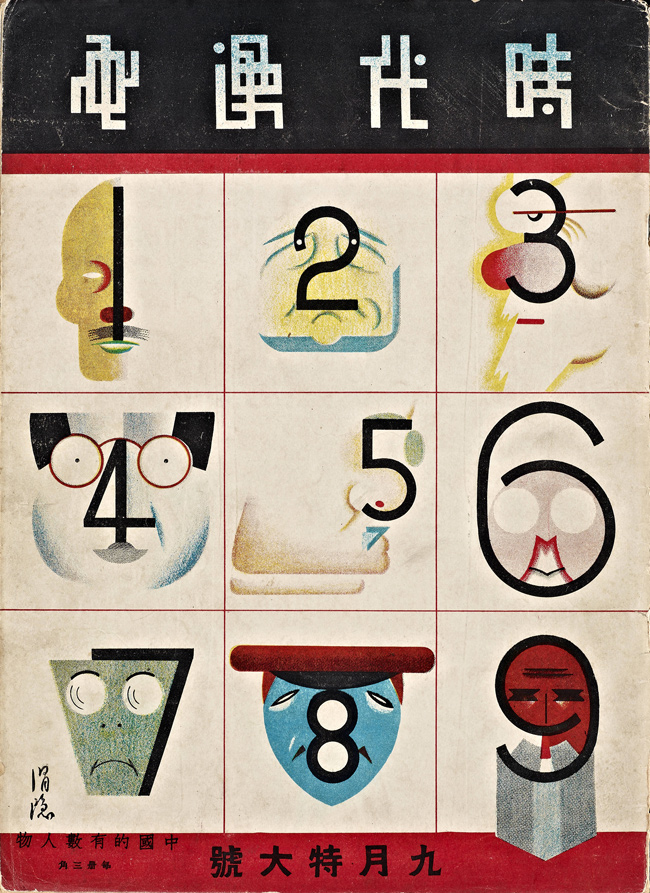 Modern Sketch issue #9
Chen Juanyin, “China’s Characters Who Count” (#1, Chiang Kai-shek...)
For the full background on this remarkable publication read John A Crespi's essay "China's Modern Sketch: The Golden Era of Cartoon Art, 1934-1937" at MIT Visualizing Cultures. Every issue can be seen in high resolution at Colgate Digital Collections -- they made the scans.
From MIT Visualizing Cultures: Modern Sketch stands out among the nearly 20 illustrated humor and satire magazines that proliferated in mid-1930s Shanghai. One can point to the remarkable openness and eclecticism of its content, and its inclusion of work by young artists who went on to become leaders in China’s 20th-century cultural establishment. Most intriguing, however, is the kaleidoscopic window onto the past that Modern Sketch provides. Without doubt the illustrations populating its pages lend blunt visual force to the major crises and contradictions that define China’s 20th century as a quintessentially modern era.
I included artist's names and translations when possible.
Modern Sketch issue #9
Chen Juanyin, “China’s Characters Who Count” (#1, Chiang Kai-shek...)
For the full background on this remarkable publication read John A Crespi's essay "China's Modern Sketch: The Golden Era of Cartoon Art, 1934-1937" at MIT Visualizing Cultures. Every issue can be seen in high resolution at Colgate Digital Collections -- they made the scans.
From MIT Visualizing Cultures: Modern Sketch stands out among the nearly 20 illustrated humor and satire magazines that proliferated in mid-1930s Shanghai. One can point to the remarkable openness and eclecticism of its content, and its inclusion of work by young artists who went on to become leaders in China’s 20th-century cultural establishment. Most intriguing, however, is the kaleidoscopic window onto the past that Modern Sketch provides. Without doubt the illustrations populating its pages lend blunt visual force to the major crises and contradictions that define China’s 20th century as a quintessentially modern era.
I included artist's names and translations when possible.
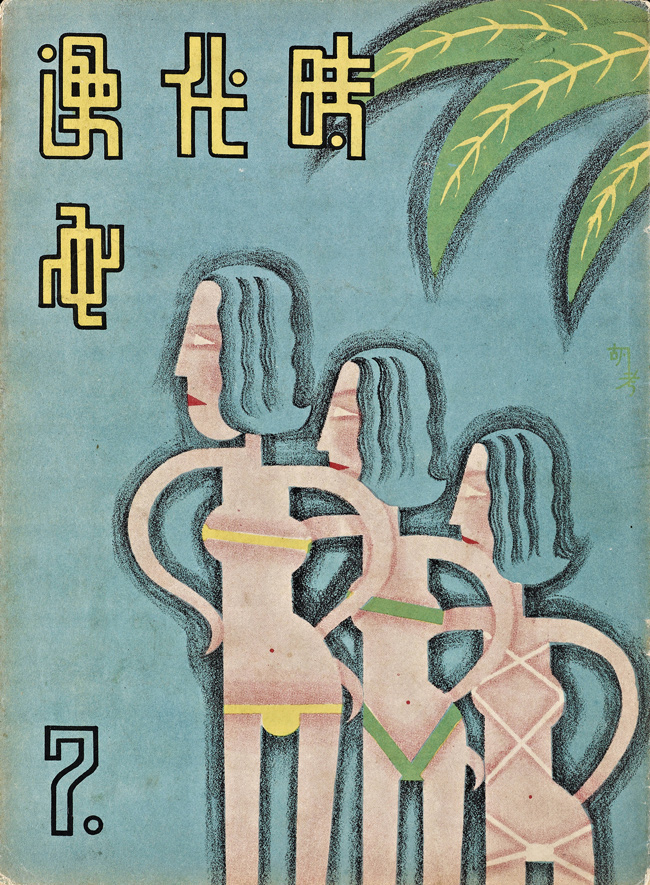 Hu Kao, “Swimsuits of 1934” (issue 7, July 1934)Crespi: "Designed to define Modern Sketch in the eyes of readers, the magazine’s full-color front covers offer a convenient point of entry into its diverse subjects and styles. What strikes the viewer’s eye now, as it surely did in the 1930s, is a consistent theme of eroticism. Nude or semi-nude figures were undoubtedly displayed to titillate the potential buyer. Yet during the first decades of the Republican period nudity could also project positive symbolic values, such as freedom, liberation, and physical health—all tropes aimed at counteracting representations of China as the tradition-bound, feeble, 'Sick Man of Asia.'"
Hu Kao, “Swimsuits of 1934” (issue 7, July 1934)Crespi: "Designed to define Modern Sketch in the eyes of readers, the magazine’s full-color front covers offer a convenient point of entry into its diverse subjects and styles. What strikes the viewer’s eye now, as it surely did in the 1930s, is a consistent theme of eroticism. Nude or semi-nude figures were undoubtedly displayed to titillate the potential buyer. Yet during the first decades of the Republican period nudity could also project positive symbolic values, such as freedom, liberation, and physical health—all tropes aimed at counteracting representations of China as the tradition-bound, feeble, 'Sick Man of Asia.'"
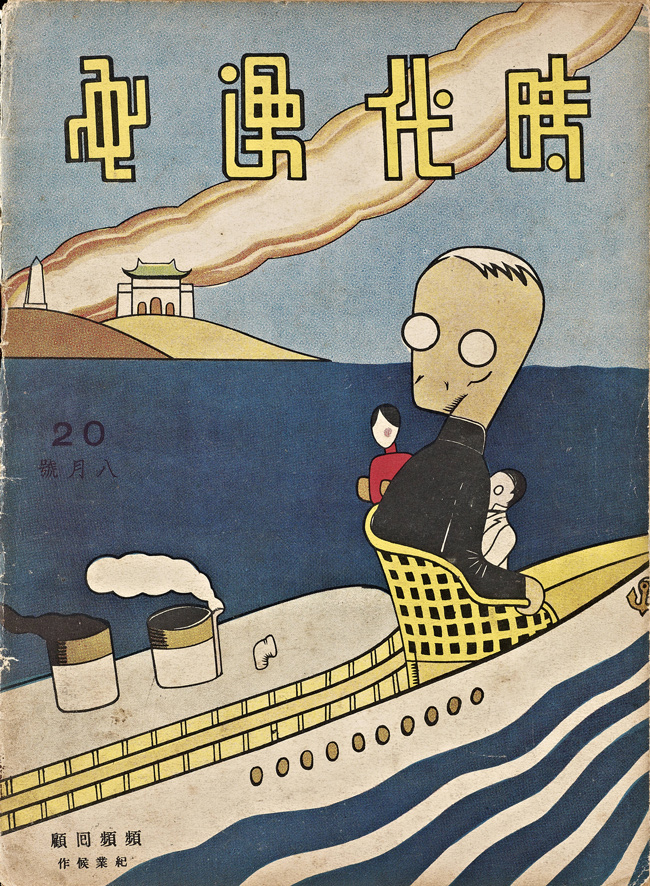
 Sheng Gongmu (Te Wei), “The Borderlands”Crespi: "Many streams of artistic influence fed the imagery of Modern Sketch. Where representations of the 'modern girl' and 'modern boy' drew mainly from stylish American jazz-age magazine illustration, other cartoonists picked and chose from among modern-art movements like cubism, surrealism, fauvism, and dada. Few rules applied to the young, almost totally uninstitutionalized art of Chinese cartooning, and the results could be fascinatingly grotesque."
Sheng Gongmu (Te Wei), “The Borderlands”Crespi: "Many streams of artistic influence fed the imagery of Modern Sketch. Where representations of the 'modern girl' and 'modern boy' drew mainly from stylish American jazz-age magazine illustration, other cartoonists picked and chose from among modern-art movements like cubism, surrealism, fauvism, and dada. Few rules applied to the young, almost totally uninstitutionalized art of Chinese cartooning, and the results could be fascinatingly grotesque."
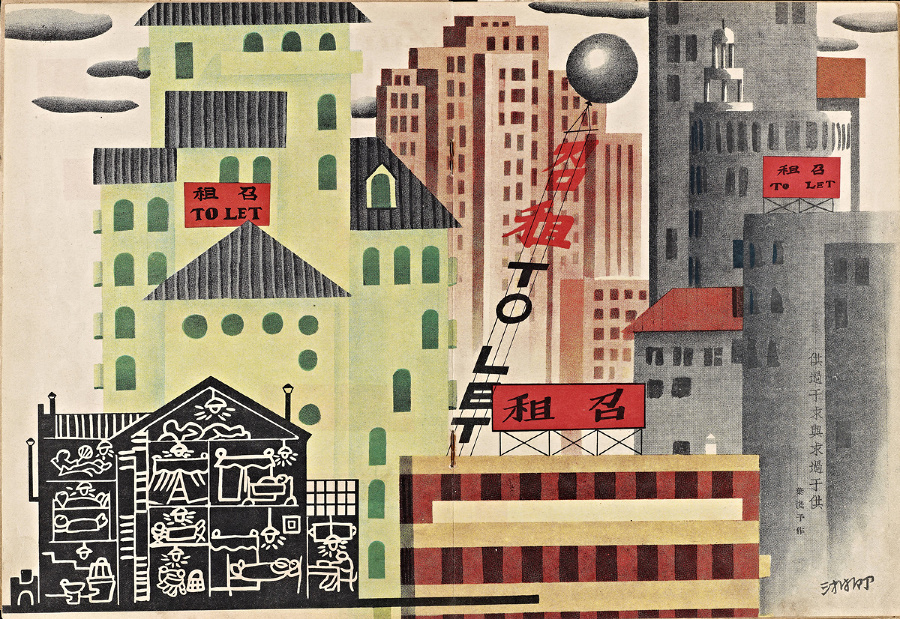 Ye Qianyu, “Supply Exceeds Demand, Demand Exceeds Supply”
Some of these can be viewed larger by clicking:
Fullscreen
Ye Qianyu, “Supply Exceeds Demand, Demand Exceeds Supply”
Some of these can be viewed larger by clicking:
Fullscreen
 Yan Zhexi, “Nothing of the Sort!”
Yan Zhexi, “Nothing of the Sort!”

 Weng Xingqing, “A World of Lines”
Weng Xingqing, “A World of Lines”
 Shang Ban Yu, “Bacteria from the ‘Sick Man of Asia’ at 2000x Magnification”
Shang Ban Yu, “Bacteria from the ‘Sick Man of Asia’ at 2000x Magnification”
 “Lineup of the World’s Dictators: Saint Fascista and His Disciples”Crespi: "...Modern Sketch did much more than react to big national and global events. Due to the vision of its editor, Lu Shaofei, the collective pictorial imagination of Modern Sketch probed all corners of the modern era, beyond and below the big stories of politics, economics, Shanghai, and even China."
“Lineup of the World’s Dictators: Saint Fascista and His Disciples”Crespi: "...Modern Sketch did much more than react to big national and global events. Due to the vision of its editor, Lu Shaofei, the collective pictorial imagination of Modern Sketch probed all corners of the modern era, beyond and below the big stories of politics, economics, Shanghai, and even China."
 Hu Kao, “The Perfect Life of Leisure!” (clockwise from top left)
— Ain’t no time for learning in the gusty old fall,
Woo woo...chee chee...a shoo shoo shoo...
— Ain’t no time for books in the warm and breezy spring,
Pa pa...doo doo...a go go go
— Ain’t no time for homework in the scorching summer,
Wah wah...lah lah...a yeah yeah yeah
— Ain’t no time to study on those chilly winter nights,
Dah dah...bom bom...a lah lah lah...
Hu Kao, “The Perfect Life of Leisure!” (clockwise from top left)
— Ain’t no time for learning in the gusty old fall,
Woo woo...chee chee...a shoo shoo shoo...
— Ain’t no time for books in the warm and breezy spring,
Pa pa...doo doo...a go go go
— Ain’t no time for homework in the scorching summer,
Wah wah...lah lah...a yeah yeah yeah
— Ain’t no time to study on those chilly winter nights,
Dah dah...bom bom...a lah lah lah...
 Huang Weiqiang, “The Internationalized Hong Kong Meat Market”
Huang Weiqiang, “The Internationalized Hong Kong Meat Market”
 Chinese opera character drawn by a child (Chen Keyan) for this 1935 cover
Chinese opera character drawn by a child (Chen Keyan) for this 1935 cover cover by Huang Yao featuring his signature character
cover by Huang Yao featuring his signature character
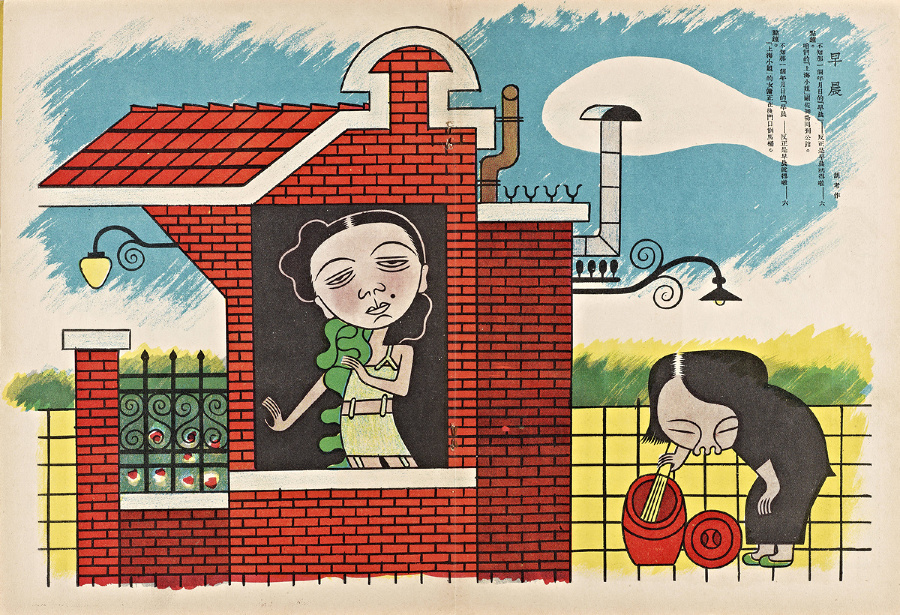
 Crespi: "Zhang Guangyu’s cheerful January 1935 contribution commemorated the Republican government’s Year of Children..."
Crespi: "Zhang Guangyu’s cheerful January 1935 contribution commemorated the Republican government’s Year of Children..."
 Pang Xunqin, “Aquatic Life”
Pang Xunqin, “Aquatic Life”



 "World Peace News Service: 'Portrait of the Chief of the Economic Survey Team,
Kodama Kenji, during His Visit to China'”
"World Peace News Service: 'Portrait of the Chief of the Economic Survey Team,
Kodama Kenji, during His Visit to China'”
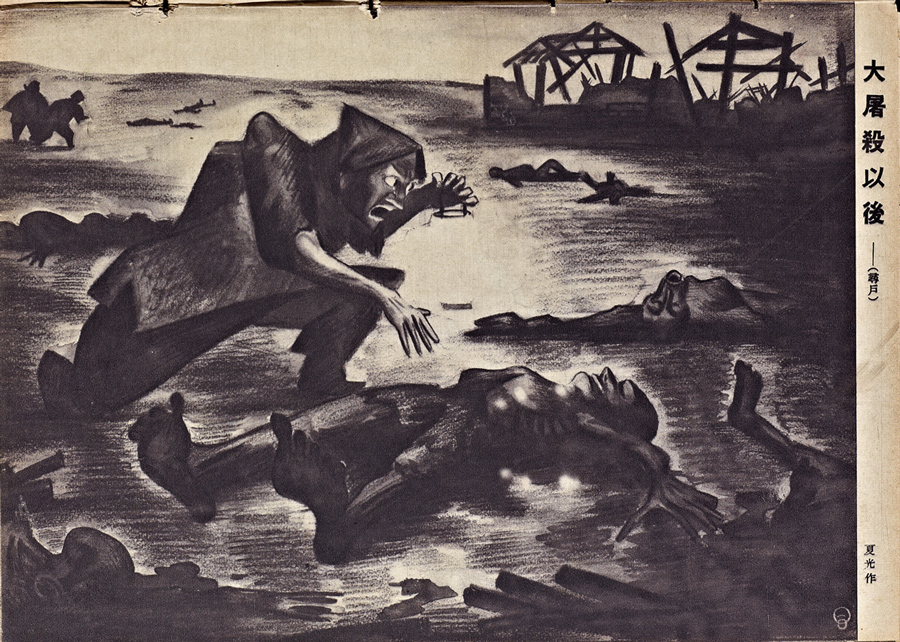
 Chen Paixi, “Official Malfeasance among the Cantonese Gentry”
Chen Paixi, “Official Malfeasance among the Cantonese Gentry”
 “Compassion for the World”
[The Pope:] The Lord Shall Provide
“Compassion for the World”
[The Pope:] The Lord Shall Provide
 Ye Qianyu, “The Second-class Rail Carriage”
Many of the illustrations have a strong Grosz influence
Ye Qianyu, “The Second-class Rail Carriage”
Many of the illustrations have a strong Grosz influence
 Ye Qianyu, cover of the second issue
Ye Qianyu, cover of the second issue Yu Yongpeng, “Competing Vehicles”
Yu Yongpeng, “Competing Vehicles”
 Yu Yongpeng, “Repairing a Rich Man’s Head”
Instructions: The face is painted green to facilitate malingering. The scalp is lubricated to slip out of tight situations. The eyes are different colors for sizing up different sorts of characters. The ears are nailed shut to help shirk responsibility. The teeth are sharp and the tongue coated with honey as an aid to persuasion. But little does the rich man know how the small-timers leech off of him!
Yu Yongpeng, “Repairing a Rich Man’s Head”
Instructions: The face is painted green to facilitate malingering. The scalp is lubricated to slip out of tight situations. The eyes are different colors for sizing up different sorts of characters. The ears are nailed shut to help shirk responsibility. The teeth are sharp and the tongue coated with honey as an aid to persuasion. But little does the rich man know how the small-timers leech off of him!
 Cover of the first issueCrespi: "Equal parts comic and gallant, this strange horseman heralded the arrival of the longest running and most influential humor and satire magazine in China during the first half of the 20th century: Shidai manhua, or by its English name, Modern Sketch. Published monthly for 39 issues from 1934 through June 1937, Modern Sketch was recognized then, and still is now, as the centerpiece of China’s golden era of cartoon art."
A sequel to this post is in the works.
See all posts tagged "China"
Cover of the first issueCrespi: "Equal parts comic and gallant, this strange horseman heralded the arrival of the longest running and most influential humor and satire magazine in China during the first half of the 20th century: Shidai manhua, or by its English name, Modern Sketch. Published monthly for 39 issues from 1934 through June 1937, Modern Sketch was recognized then, and still is now, as the centerpiece of China’s golden era of cartoon art."
A sequel to this post is in the works.
See all posts tagged "China"